Lavender is one of the most popular herbs to grow in hanging baskets. With its trailing stems and colorful blooms cascading over the edges, lavender creates a beautiful display that is perfect for adorning balconies patios, porches, and more.
In this comprehensive guide, we’ll discuss why lavender is such a great choice for hanging baskets and provide tips for selecting the best varieties, caring for your plants, and designing an eye-catching lavender hanging basket garden.
Why Choose Lavender for Hanging Baskets
There are many reasons why lavender makes an excellent addition to hanging baskets
-
Compact Growth Habit – Many lavender varieties have a nice compact, rounded shape that fits well in the confined space of a hanging basket.
-
Fragrance – Lavender is prized for its fresh, floral scent that perfumes the air. Hanging baskets allow you to position that fragrance where you can best enjoy it.
-
Long-Lasting Color – The showy flower spikes add long-lasting color through spring and summer. As they bloom, the flowers cascade attractively over the basket edges.
-
Low Maintenance – Once established, lavender thrives with minimal care. The free-draining environment of a hanging basket also suits it perfectly.
-
Drought Tolerance – Lavender’s Mediterranean origins mean it’s well-adapted to dry conditions. It thrives in the sandy, well-draining mix that hanging baskets provide.
-
Pollinator Appeal – Bees, butterflies, and other pollinators flock to the nectar-rich blooms of lavender.
With benefits like these, it’s easy to see why lavender is a top choice for spilling color and fragrance from hanging baskets.
Selecting the Best Lavender Varieties
With over 40 different lavender species, there are many options to choose from. Look for varieties described as compact or dwarf, as they will fit best in the confined space of a hanging basket.
Some excellent lavender varieties for hanging baskets include:
-
English Lavender – Compact varieties like ‘Munstead’, ‘Hidcote’, and ‘Twickle Purple’ work well in containers.
-
Spanish Lavender – ‘Melissa Lilac’ is a dwarf Spanish lavender with upright blooms.
-
French Lavender – Try ‘Grosso’ for its bushy shape and prolific flowering.
-
Lavandin – Hybrids like ‘Ellagance Purple’ offer early blooms and sturdy growth.
-
Miniature Lavender – Petite varieties like ‘Mini Blue’ work perfectly in small hanging baskets.
Consider bloom color, growth habit, and size when selecting lavender varieties to find the perfect fit for your hanging baskets.
Providing the Right Growing Conditions
Lavender thrives when given the following care:
-
Sun – For prolific blooms, lavender requires full sun – at least 6 hours of direct sunlight daily.
-
Soil – Good drainage is key. Use a lightweight potting mix amended with extra perlite or gravel.
-
Watering – Allow soil to dry out between waterings, then soak thoroughly. Err on the side of under-watering with lavender.
-
Fertilizer – Apply a balanced liquid fertilizer every 2-4 weeks during spring and summer.
-
Pruning – Trim plants after initial flowering to encourage bushy new growth.
By providing optimal growing conditions, your lavender is sure to thrive and flower beautifully all season long.
Designing Creative Lavender Hanging Gardens
When designing lavender hanging baskets, consider these tips:
-
Combine different lavender varieties for a colorful cascade of blooms
-
Partner with other Mediterranean herbs like rosemary, thyme, and oregano
-
Add pollinator-friendly companions such as daisies, marigolds, and bee balm
-
Include trailing plants like ivy, lobelia, and creeping Jenny for draping foliage
-
Incorporate textural contrasts with delicate ferns, ornamental grasses, or succulents
-
Weave in decorative elements like ribbons, chimes, or glass gemstones
-
Place your lavender hangers where you can enjoy the fragrance – near seating areas or walkways
-
Use lavender in a tiered display with baskets of varying sizes
With the right companion plants, decorations, and placement, you can create a stunning lavender hanging garden.
Caring for Lavender in Hanging Baskets
Caring for lavender in hanging baskets is easy with proper planting and care:
-
Select a lightweight potting mix and amend with extra perlite or gravel to ensure excellent drainage.
-
Place a layer of landscape fabric over drainage holes to maintain airflow to plant roots.
-
Set new plants at the same soil level they were growing at the nursery. Don’t plant too deeply.
-
Water thoroughly after planting and allow the soil to dry out between waterings.
-
Apply a balanced organic fertilizer at planting and monthly through the growing season.
-
Prune back lightly after initial flowering to encourage bushy regrowth. Avoid heavy fall pruning.
-
Bring baskets indoors before frost if growing lavender as an annual.
With the right care, your lavender hanging baskets will thrive season after season.
Common Problems and Solutions
Here are some potential issues and how to address them:
-
Root rot – Improve drainage and water less frequently.
-
Leggy growth – Prune regularly and ensure adequate sunlight.
-
Few blooms – Fertilize to encourage flowering and prune to shape plants after blooming.
-
Discoloration – Treat any disease issues promptly and improve air circulation.
-
Winter damage – Protect plants by overwintering indoors in cold climates.
With proper care, pests and diseases rarely bother lavender. But if issues arise, early treatment can get your plants back to health.
Bring the Beauty of Lavender to Your Outdoor Space
With its trailing purple blooms and lovely scent, lavender is a wonderful addition to any hanging basket display. Select compact varieties suited to container culture and give them plenty of sun and well-drained soil. With the right care, you’ll be rewarded with stunning lavender hangers that perfume your garden with beauty and fragrance.
Hanging lavender baskets are an easy way to add a touch of Mediterranean charm to your outdoor living space. Let this adaptable herb spill from your pots and envelop your garden in its familiar floral fragrance.
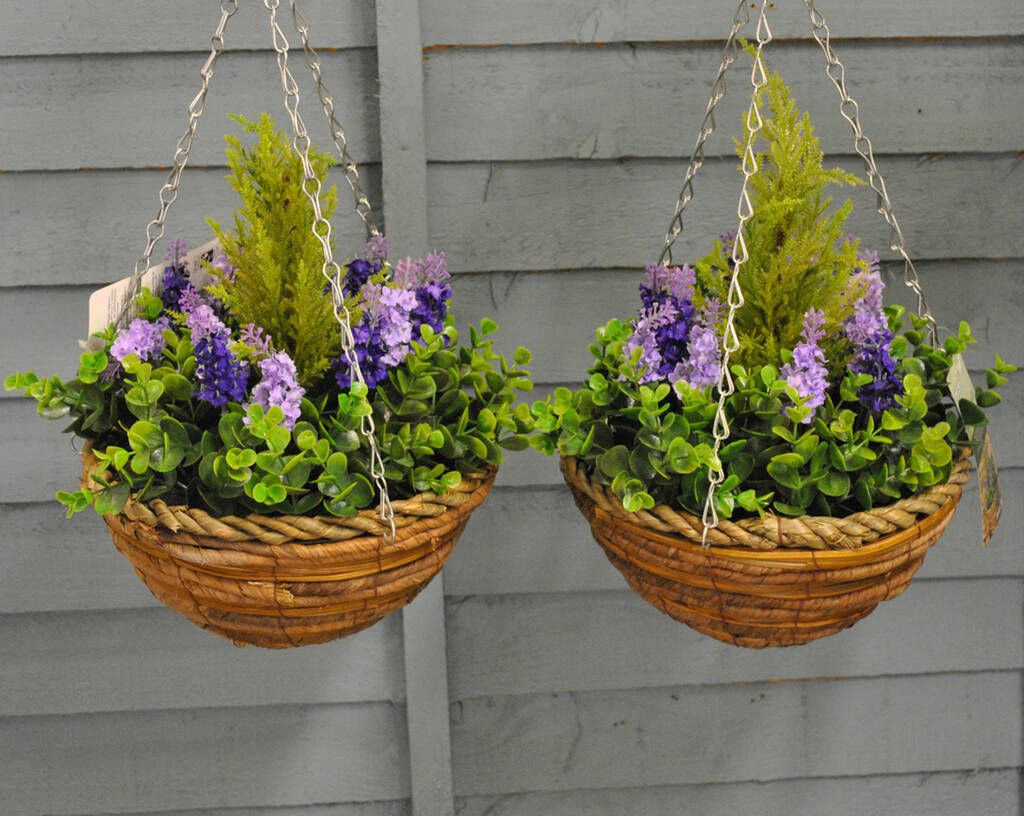
How to plant up hanging baskets
To plant up a hanging basket, you will need:
- Potted plants
- Hanging basket
- Basket liner or sphagnum moss
- Short, wide, and a small plastic pot
- Multipurpose compost
- Water-retaining crystals (optional)
- Newspaper and scissors
Choosing plant selections for hanging baskets
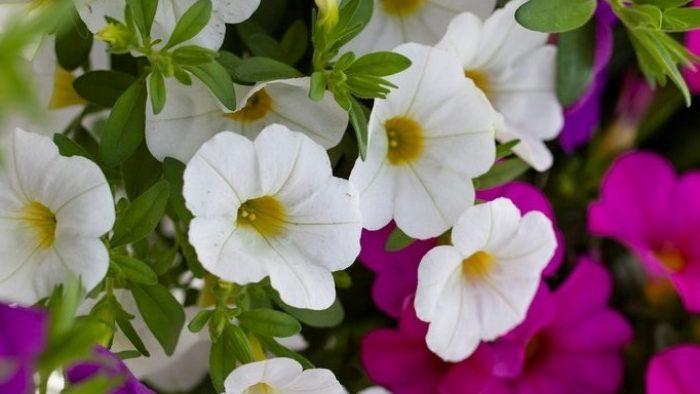
Petunias are a popular plant for hanging baskets because they are versatile. Petunias come in a wide range of colours and sizes, making them suitable for a variety of design styles. They are easy to care for, are low-maintenance, and require minimal care, making them ideal for a busy gardener. Petunias are also fast-growing and can quickly fill a hanging basket, adding colour and interest to your outdoor space.
To grow petunias, ensure that they have plenty of sunlight; ideally placed in full sun or partial shade. You will need well-draining soil with a pH between 6.0 and 7.0. Petunias require regular watering, but avoid overwatering to prevent root rot. They benefit from regular application of fertiliser, especially during the growing season.
Petunias look good with many different plants, including:
- Ferns add a soft, delicate texture to the basket and complement the bold petunias.
- Trailing ivy adds a trailing element to the basket and provides a contrast to the upright petunias.
- Geraniums have a similar growth habit to petunias and can add additional colour and interest to the basket.
- Bengolias add a delicate, contrasting flower and leaf texture to the basket, complementing the bold petunias.
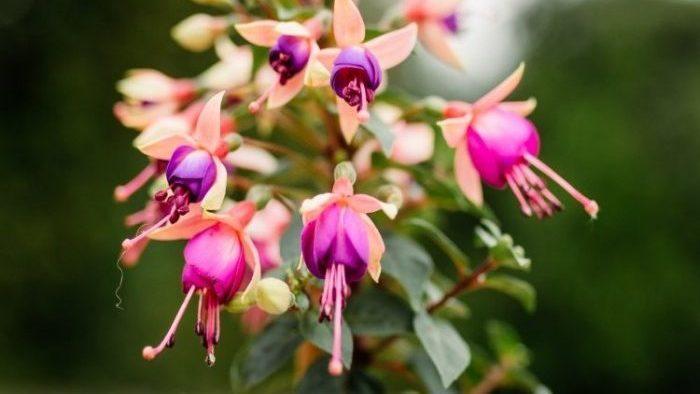
Fuchsias are perfect for hanging baskets because they have beautiful, pendulous flowers in a range of colours, including pink, red, purple, red and white. They can also be grown in the sun or shade, making them suitable for a variety of locations. Fuchsias also typically bloom from early summer to late fall, providing a long season of colour.
But be sure to grow them in the right conditions. Fuchsias prefer partial shade, although they can also grow in full sun if kept well-watered. They need well-draining soil that is moist but not waterlogged. Regular watering is essential during hot, dry weather and they also benefit from regular applications of fertiliser, especially in the growing season.
Fuchsias look good with a variety of plants, including:
- Ivy adds a trailing element to the basket and provides a contrast to the pendulous fuchsias.
- Ferns add a soft, delicate texture to the basket and complement the bold fuchsias.
- Geraniums have a similar growth habit to fuchsias and can add additional colour and interest to the basket.
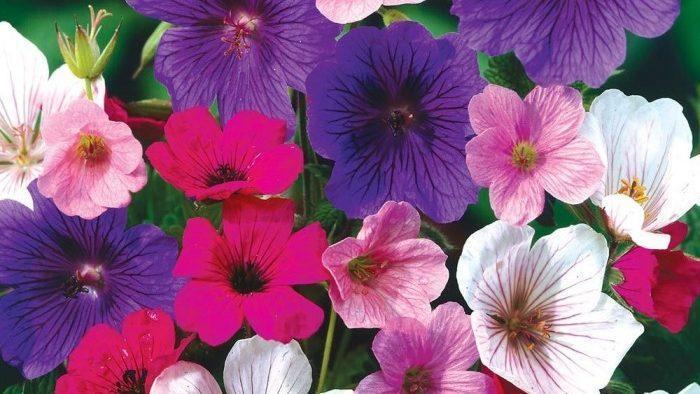
Geraniums are a popular plant for hanging baskets for many reasons. Geraniums have bright, showy flowers in a range of colours, including pink, red, orange, and white. They can be grown in the sun or shade, making them suitable for a variety of locations. Geraniums are low-maintenance and require minimal care, making them ideal for busy gardeners.
Geraniums prefer full sun to partial shade, they also need well-draining soil with a pH between 6.0 and 7.0. Geraniums require regular watering, but avoid overwatering to prevent root rot. They also benefit from regular application of fertiliser, especially during the growing season.
We recommend adding geraniums to a hanging basket with:
- Ferns – to add a soft, delicate texture to the basket and complement the bold geraniums.
- Trailing Ivy – adding a trailing element to the basket and providing a contrast to the upright geraniums.
- Petunias – these have a similar growth habit to geraniums and can add additional colour and interest to the basket.
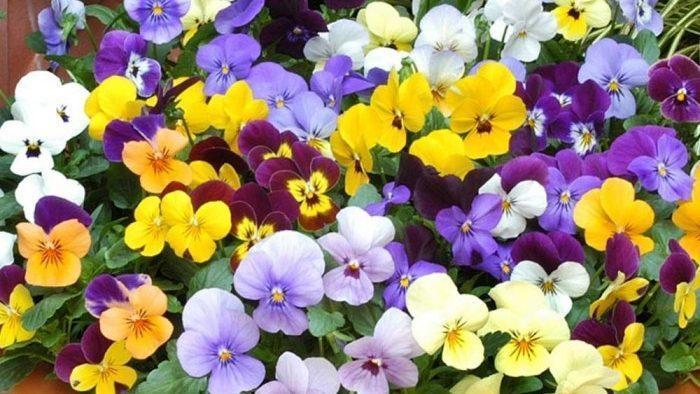
Violas are a popular plant for hanging baskets because they are Colourful, with small, cheerful flowers in a range of colours, including blue, purple, yellow, and white. Violas typically bloom from early spring to late autumn, providing a long season of colour. They can grow well in partial shade, making them suitable for locations that receive less sunlight.
Violas prefer partial shade to full sun in well-draining soil that is moist but not waterlogged. Violas need regular watering, especially in hot, dry weather. They also benefit from regular application of fertiliser, especially during the growing season.
Violas look good with:
- Ferns – to add a soft, delicate texture to the basket and complement the small, cheerful violas.
- Ivy – adds a trailing element to the basket and provides a contrast to the upright violas.
- Pansies – these have a similar growth habit to violas and can add additional colour and interest to the basket.
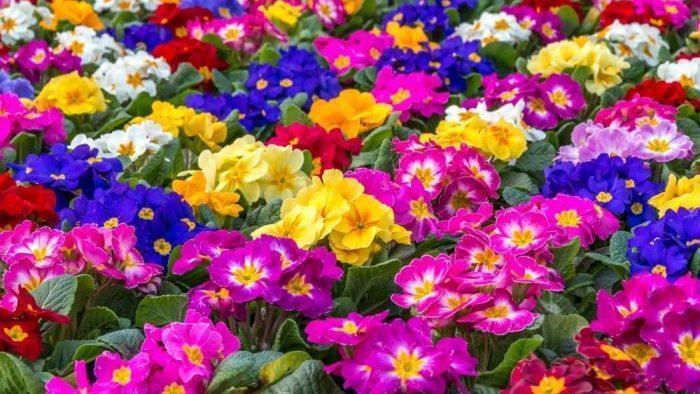
Primroses are a popular plant for hanging baskets because they are vibrant, showy flowers in a range of colours, including yellow, pink, red, and blue. Primroses are one of the first plants to bloom in spring, providing an early season of colour. They can grow well in partial shade, making them suitable for locations that receive less sunlight.
Primroses prefer partial shade to full sun. With well-draining soil that is moist but not waterlogged. Primroses need regular watering, especially in hot, dry weather. They also benefit from regular application of fertiliser, especially during the growing season.
Primroses look good with:
- Ferns – Ferns add a soft, delicate texture to the basket and complement the vibrant primroses.
- Ivy – Ivy adds a trailing element to the basket and provides a contrast to the upright primroses.
- Pansies – Pansies have a similar growth habit to primroses and can add additional colour and interest to the basket.
- Forget-me-nots – Forget-me-nots have delicate blue flowers that complement the primroses and add additional colour to the basket
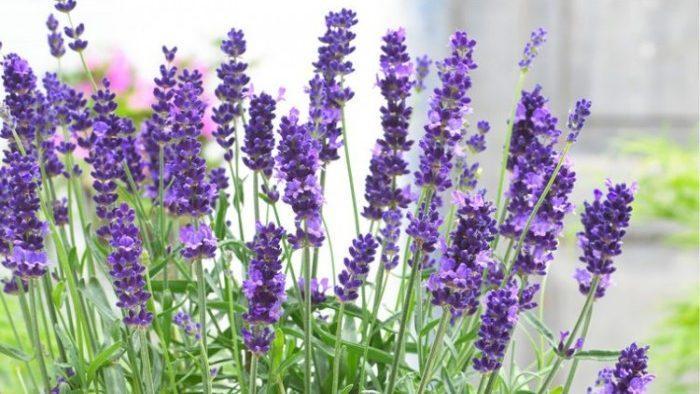
Lavender is a good plant to grow in hanging baskets because it is known for its sweet, fragrant aroma, which adds a sensory element to the basket. It is an easy-to-grow plant that requires little attention once established. Lavender typically blooms from late spring to early summer, providing a long season of colour.
Lavender prefers full sun and does best in areas with 6 or more hours of direct sun per day. They need well-draining soil that is moist but not waterlogged. Lavender is a drought-tolerant plant but needs regular watering in hot, dry weather. They benefit from the occasional application of fertiliser, especially during the growing season. Check out our care guide for lavender.
Lavender looks good with:
- Thyme – Thyme has a similar growth habit to lavender and provides a contrasting fragrance and colour to the basket.
- Rosemary – Rosemary adds a trailing element to the basket and complements the upright lavender.
- Sedum – Sedum has a trailing habit and provides a contrasting texture to the basket.
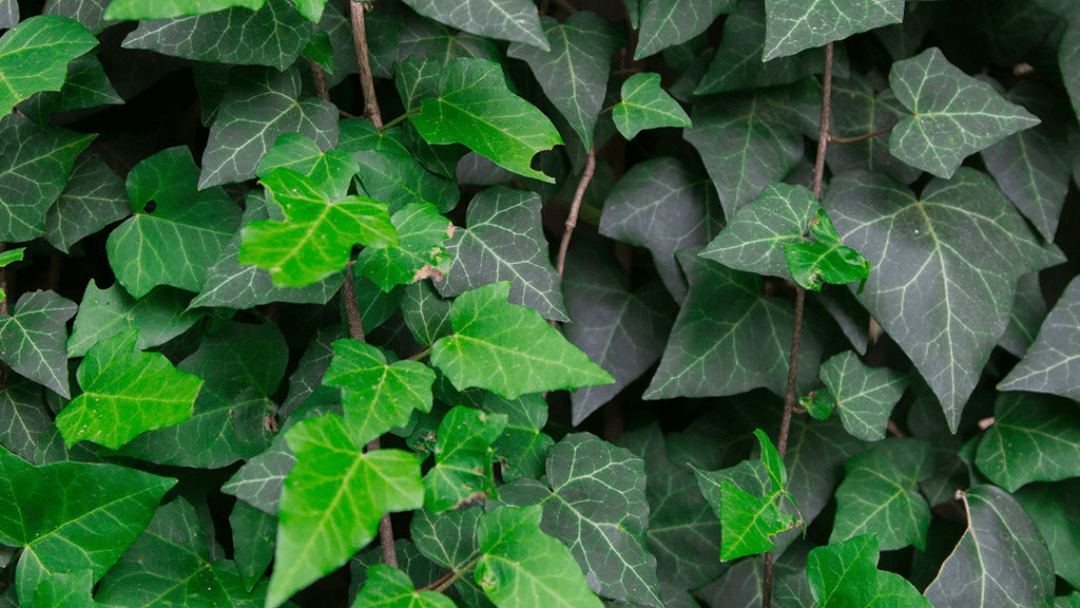
Ivy is a good plant to grow in hanging baskets because it has a trailing habit and glossy, green leaves that add texture to the basket. It is an easy-to-grow plant that requires little attention once established. Ivy can help to create a shady microclimate in the basket, which is especially beneficial for other plants that need protection from the sun.
Ivy prefers shade to partial shade, although it can also grow in full sun if the soil remains consistently moist. They need well-draining soil that is moist but not waterlogged. Ivy needs regular watering in hot, dry weather. Ivy benefits from the occasional application of fertiliser, especially during the growing season.
Ivy looks good with:
- Ferns – Ferns have a similar growth habit to ivy and provide a complementary texture to the basket.
- Petunias – Petunias have a mounding habit and provide a pop of colour to the basket.
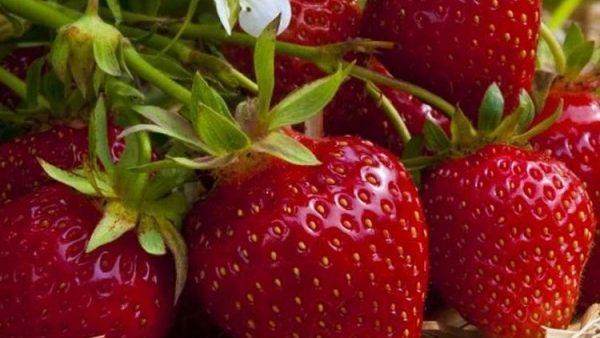
Strawberries can be grown in hanging baskets and make an attractive and productive addition to your outdoor space. Strawberry plants need full sun for 6-8 hours per day to produce healthy growth and fruit. They prefer well-draining soil with a pH between 6.0 and 6.5. Strawberry plants need regular watering, especially when fruiting. Strawberry plants benefit from regular application of fertiliser, especially during the growing season.
Strawberries look good with herbs, such as basil, rosemary, and thyme, which provide a complementary fragrance and flavour to the strawberries. Flowers, such as petunias and geraniums, provide a pop of colour to the basket. Lettuce and greens, such as spinach, provide a contrasting texture and flavour to the strawberries.
How to Grow Bigger Hanging Baskets
FAQ
Does lavender grow well in hanging baskets?
Growing lavender in containers or as part of a hanging basket garden is easy and a good idea if you have poor soil for lavender in the rest of your garden. Known for its preference for dry conditions, established plants will thrive within container culture.
What kind of lavender is best for hanging baskets?
- Lavandula angustifolia ‘Miss Katherine’ (Lavender) …
- Lavandula angustifolia ‘Munstead’ (Lavender) …
- Lavandula angustifolia ‘Nana Alba’ (Lavender) …
- Lavandula angustifolia ‘Rosea’ (Lavender) …
- Lavandula angustifolia ‘Thumbelina Leigh’ (Lavender)
Does lavender like full sun or shade?
Light: Lavender needs full sun and well-drained soil to grow best. In hot summer climates, afternoon shade may help them thrive. Soil: Lavender grows best in low to moderately-fertile soils, so don’t amend the soil with organic matter before planting.
What is the 888 rule for lavender?
